A research team from Harvard School of Engineering and Applied Sciences (SEAS) led by Associate Professor of Chemical engineering Vinothan Manoharan has established that emulsions, which are stabilised take a longer time to achieve equilibrium. It was earlier understood that this process happened instantaneously or during a small period of time.
 Image courtesy of Flickr user Daniel Kulinski (color added), under a Creative Commons license.
Image courtesy of Flickr user Daniel Kulinski (color added), under a Creative Commons license.
Emulsions are combinations of two liquids that are insoluble such as oil and water. Usually manufacturers add stabilising particles in order to create Pickering emulsions, which are used in products like mayonnaise or sunscreen to increase their shelf life.
When the combinations in the emulsion completely mix with each other, then the emulsion is said to have attained equilibrium. Emulsions attaining equilibrium depends on other factors apart from the properties of the materials such as the time and energy put into the system. For the purpose of research, Manoharan and his colleagues studied the interface between water and oil using holography. After this they introduced various particles to the interface by using a laser focus. It was found out that none of the particles achieved equilibrium instantly. Though they managed to break the interface they slowed down as they approached oil. According to the team, the process of achieving equilibrium could take months to years. This finding is likely to have a great impact on biomedical engineering, chemical engineering, manufacturing nanostructured materials, water purification and mineral recovery methods.